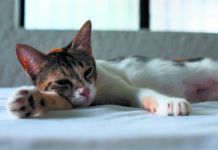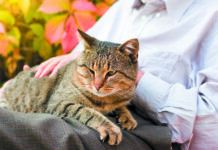Q My longhaired cat, Pretty Kitty, seems to groom her beautiful silver coat all the time. She is an indoor-only cat nearing her fifth birthday. At least once or twice a week, I can count on finding a hairball coughed up on the carpet. She never seems to pick floors that are easy to clean, like the tile in the kitchen. She gets regular checkups, and my veterinarian has not found any health problems. So why the hairballs?
A Unfortunately, hairballs can be a constant nagging issue for longhaired cats and many shedding shorthaired ones as well. Cats normally swallow hair when they groom. The tiny barbs on their tongue act like a hairbrush, grabbing loose hair. Most of the time, this swallowed hair passes through the digestive system without incident.
However, when cats have a lot of hair to begin with or are shedding, swallowed hair accumulates in the stomach where it can irritate the stomach lining and interfere with digestion. Once the hairball reaches a certain size, the cat vomits to expel a messy wad of hair, digested food, saliva, and gastric secretions — the ingredients of your typical feline hairball. Yuck!
I urge you to consult with your veterinarian again if the number of hairball incidents increases or if you cat appears to be in discomfort when she vomits. A radiograph may be necessary to determine if a hairball is stuck in her stomach. In some cases, impacted hairballs must be surgically removed.
Even though Pretty Kitty is quite a fastidious groomer, you can help reduce the hairball incidents by brushing and combing her daily. Grooming also aids in spotting any skin or coat problems such as lumps, bumps, and fleas, removes dead skin, and minimizes matting. Your clothing and furniture will benefit, too, because there will be less flyaway cat hair circulating in your house. You can also treat her to an appointment at a pet-grooming salon on a regular basis.
Another way to combat hairballs is to feed your cat a petroleum-based lubricant, available from your veterinarian or at most pet supply stores. Some cats tolerate straight Vaseline, but many don’t like the taste. Whichever brand you use, dab a bit on your cat’s nose or paw. She will automatically lick that area and ingest the lubricant. Most of these are flavored to encourage cats to view them as a treat. Do not use butter or vegetable oil as they are high in calories and not absorbed efficiently by cats. Virgin olive oil can be used sparingly.
Why the carpet and not the tile floor? That remains one of the feline mysteries in life. My home is mostly laminate and tile, but whenever my cats have upset tummies, they too leave the evidence on the only carpeted area of my house — my bedroom and upstairs hallway.
To learn more about your cat’s behavior, purchase The Cat Behavior Answer Book from Catnip.



